A New Covenant: Also Dedicated with Blood (Heb 8:7-9:22)
Structural Laws
[todo]
New Covenant: Better than the Old (8:6-13)
7 For if that first covenant had been faultless, there would have been no occasion sought for a second. 8 For finding fault with them, He says, “Behold, days are coming, says the Lord, When I will effect a new covenant With the house of Israel and with the house of Judah; 9 Not like the covenant which I made with their fathers On the day when I took them by the hand To lead them out of the land of Egypt; For they did not continue in My covenant, And I did not care for them, says the Lord. 10 “For this is the covenant that I will make with the house of Israel
After those days, says the Lord: I will put My laws into their minds, And I will write them on their hearts. And I will be their God, And they shall be My people. 11 “And they shall not teach everyone his fellow citizen, And everyone his brother, saying, ‘Know the Lord,’ For all will know Me, From the least to the greatest of them. 12 “For I will be merciful to their iniquities, And I will remember their sins no more.”
13 When He said, “A new covenant,” He has made the first obsolete. But whatever is becoming obsolete and growing old is ready to disappear.
A new covenant: not according to the covenant he made with their fathers, but with them.
8:7 (<-) There needed change b/c there was no perfection under the law (have to be perfect but can’t)
the word translated “new” covenant could also be translated “renewed” covenant.
(Heb 8:8)
“There was nothing wrong with the covenant — the people were to blame. ‘Finding fault with them,’ not it.” J. Vernon McGee
8:9 “ Egypt” slavery and bondage
8:10 The new covenant will be written on hearts, not on tablets of stone, so that they will be able to obey it.
(Heb 8:11)
“The first covenant was meant to be written on people’s hearts, and the righteous actually had it there, but according to Jeremiah, most of Israel did not have it in their hearts.” The Bible Background Commentary
8:12 A full forgiveness of sin.
8:13 What is “becoming obsolete and growing old”? The temple? It stood for another five years or so after this letter was written. The whole temple system? We have a new covenant now.
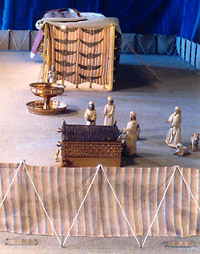 A Better Sanctuary (9:1-10)
A Better Sanctuary (9:1-10)
9 Now even the first covenant had regulations of divine worship and the earthly sanctuary. 2 For there was a tabernacle prepared, the outer one, in which were the lampstand and the table and the sacred bread; this is called the holy place. 3 Behind the second veil there was a tabernacle which is called the Holy of Holies, 4 having a golden altar of incense and the ark of the covenant covered on all sides with gold, in which was a golden jar holding the manna, and Aaron’s rod which budded, and the tables of the covenant; 5 and above it were the cherubim of glory overshadowing the mercy seat; but of these things we cannot now speak in detail.
Now we are contrasting two ministries, the Levitical Service and the Priesthood of Jesus.
Then indeed, even the first covenant had ordinances of divine service and the earthly sanctuary. (Heb 9:1)
9:1 sanctuary = place of worship.
contrast: “divine service” vs. “earthly sanctuary”
service = could have been translated as “worship” (McGee)
earthly or worldy = doesn’t imply secular or profane, but rather the other meaning of worldly, made of materials of this world, on this earth (as opposed to in heaven).
For a tabernacle was prepared: the first part, in which was the lampstand, the table, and the showbread, which is called the sanctuary; (Heb 9:2)
Why would the author go back to the tabernacle to make his illustration rather than any of the three temples, including Herod’s temple which was believed to still be in use at the time this letter was written?
|
Symbolism of Holy Place (McGee)
|
|
| Where the priests served and worshiped | We worship God by doing these things |
| lampstand | walking in the light of His presense (ie: in obedience to him) |
| table with showbread | feed upon God’s word, the bread of life |
| altar of incense | prayer |
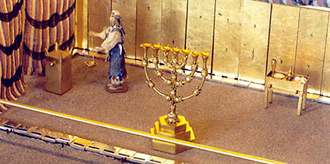
The Holy Place in the Tabernacle
containing: the lampstand, showbread table, and altar of incense
9:2 “showbread” Jesus: I am the bread
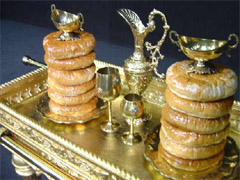
Table of Showbread
and behind the second veil, the part of the tabernacle which is called the Holiest of All, (Heb 9:3)
|
Symbolism of Most Holy Place (McGee)
|
|
| Ark of the Covenant | Christ? (see ark contents) |
| Blood sprinkled on Mercy Seat | Remission of Sins |
| Entrance to the Most Holy Place | Direct Access to God |
which had the golden censer and the ark of the covenant overlaid on all sides with gold, in which were the golden pot that had the manna, Aaron’s rod that budded, and the tablets of the covenant; (Heb 9:4)
The tablets of the covenant represented the permanent record of the terms of the old covenant (they were kept in the most sacred place).
Issue: What is the golden censer here? Is it the portable censer (container for hot coals and insense) that the high priest would carry into the Most Holy Place on the day of atonement? Or is this the Golden Altar that in the tabernacle was in the Holy Place? McGee asserts that it is the Golden Altar, moved into the most holy place because there is no longer a seperation since the veil was torn. In support of his theory is the lack of mention of the Altar in the holy place in this discription. Also, as the altar represented prayer, it is both inside and outside as Jesus is inside the holy of holies (in the presense of God) always making intercession for us, but we are outside the holy of holies, coming to God through prayer.
|
Symbolism of Ark Contents (McGee)
|
|
| Ten commandments tablets | Jesus came to fulfill the law |
| Pot of manna | Jesus is the bread of life. |
| Aaron’s rod that budded | Jesus’s resurrection |
The pot of manna: The ministry of Christ. “The bible is God’s bakery, and if you want bread, that is where you will go to get it” (McGee). The manna is symbolic of feeding people with the bread of life (the Word of God).
The rod: life came into a dead rod for it to bud. The dead coming back to life. This is symbolic of Jesus being resurrected from the dead.
What is the symbolism of it being Aaron’s rod, not Moses’s rod that was the one that budded? There was a distinction between the two rods when Moses struck the rock the two times.
9:4 covenant = vow, contract, but stronger than a contract, it’s not dependent on the other person.
“golden censer” Incense rev 8:3-4
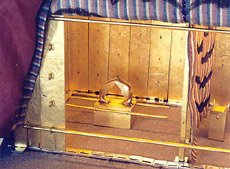
The Most Holy Place
Containing the Ark of the Covenant
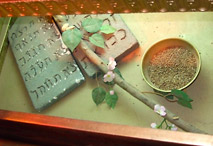
Contents of the Ark of the Covenant
(Golden Pot that had manna, Aaron’s rod that budded, tablets of the covenant)
and above it were the cherubim of glory overshadowing the mercy seat. Of these things we cannot now speak in detail. (Heb 9:5)
9:5 “cherubim” God dwells in the midst of the cherubim. [See Sidebar on Cherubim PDF 354kb]. Cherubim were angelic winged creatures designed to worship God.
What does these things refer to? The earthly tabernacle? The cherubim? McGee interprets this is the author trying to not get sidetracked into dwelling on a lengthy discussion of the tabernacle, but to get back to his main point, about the better priesthood and how to worship God.
6 Now when these things have been so prepared, the priests are continually entering the outer tabernacle performing the divine worship, 7 but into the second, only the high priest enters once a year, not without taking blood, which he offers for himself and for the sins of the people committed in ignorance. 8 The Holy Spirit is signifying this, that the way into the holy place has not yet been disclosed while the outer tabernacle is still standing, 9 which is a symbol for the present time. Accordingly both gifts and sacrifices are offered which cannot make the worshiper perfect in conscience, 10 since they relate only to food and drink and various washings, regulations for the body imposed until a time of reformation.
Now when these things had been thus prepared, the priests always went into the first part of the tabernacle, performing the services. (Heb 9:6)
always = indicative of continous action. The priests never finished their job.
“The priests always went intot he first part of the tabernacle, performing the services” -> The holy place?
Service of God = worship of God. Worship = giving someone somethign of which they are worthy. Jesus is worthy of our praise and adoration. Service follows out of this, not the other way around.
Worship: We worship in spirit and truth (John 4:23), worship as a song in the heart (Eph. 5:18-19)
These tabernacle rituals never brought the people into the presence of God.
But into the second part the high priest went alone once a year, not without blood, which he offered for himself and for the people’s sins committed in ignorance; (Heb 9:7)
Once a year = on Yom Kippur, the day of atonement.
Our high priest has gone in, once, into the holy of holies, and has not yet come out. He’s not repeatedly coming in and out with a rope tied around his foot in case he does not honor God correctly and gets smited.
the Holy Spirit indicating this, that the way into the Holiest of All was not yet made manifest while the first tabernacle was still standing. (Heb 9:8)
The way into the presense of God wasn’t opened yet.
It was symbolic for the present time in which both gifts and sacrifices are offered which cannot make him who performed the service perfect in regard to the conscience– (Heb 9:9)
9:9 “cannot make him who performed the service perfect in regard to the conscience” limited.
concerned only with foods and drinks, various washings, and fleshly ordinances imposed until the time of reformation. (Heb 9:10)
9:10 “fleshly ordinances” the law = fleshly
|
Summary of the Earthly Sanctuary (McGee)
|
|
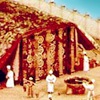 |
|
A Superior Sacrifice (9:11-22)
11 But when Christ appeared as a high priest of the good things to come, He entered through the greater and more perfect tabernacle, not made with hands, that is to say, not of this creation; 12 and not through the blood of goats and calves, but through His own blood, He entered the holy place once for all, having obtained eternal redemption. 13 For if the blood of goats and bulls and the ashes of a heifer sprinkling those who have been defiled sanctify for the cleansing of the flesh, 14 how much more will the blood of Christ, who through the eternal Spirit offered Himself without blemish to God, cleanse your conscience from dead works to serve the living God?
9:11 note that the “good things to come” in this verse have already come to pass.
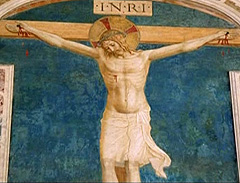 Not with the blood of goats and calves, but with His own blood He entered the Most Holy Place once for all, having obtained eternal redemption. (Heb 9:12)
Not with the blood of goats and calves, but with His own blood He entered the Most Holy Place once for all, having obtained eternal redemption. (Heb 9:12)
Entered the real most holy place in heaven to cleanse it? Took his blood to heaven literally?
The priests had to repeatedly enter, with a temporary result. Christ enters “once and for all”, one time, with a permanant result. A superior sacrifice.
For if the blood of bulls and goats and the ashes of a heifer, sprinkling the unclean, sanctifies for the purifying of the flesh, (Heb 9:13)

An Animal Sacrifice Outside Tabernacle
Ashes of a heifer is a reference to the ceremonial cleansing for defilement (see Numbers 19). To be purified, a red heifer without blemish or defence, that have never had a yoke on it had to be slaughtered outside the camp by the high priest (eg: Eleazar), and the blood sprinkled seven times. Cedar and hyssop were to be tied with scarlet woold and thrown into the fire of the burning heifer. Christ was without blemish or defect, he never had the yoke of bondage to sin. When Jesus was slain, he was both the offering and the high priest. Sprinkling the blood seven times is symbolic of completeness of the sacrifice. Christ’s sacrifice was certainly complete. Plants from “Cedar to hyssop” is representative of all plants (See 1 Kings 4:33), which could be a symbolic way of saying Christ’s sacrifice wasn’t just for man, but Christ’s sacrifice being redeming for all of nature.
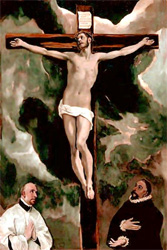 how much more shall the blood of Christ, who through the eternal Spirit offered Himself without spot to God, cleanse your conscience from dead works to serve the living God? (Heb 9:14)
how much more shall the blood of Christ, who through the eternal Spirit offered Himself without spot to God, cleanse your conscience from dead works to serve the living God? (Heb 9:14)
This verse makes an important point that is easy to overlook. Sacrificing of heifers was good for cleaning the flesh, but Christ also cleanses our consciences.
To serve = to worship again
cleansing…to serve the living god: Cleansing results in works, rather than works causing cleansing, as we are not saved by works.
“The reference to the ashes of a heifer is found in Numbers 19, wherein we read that when a person came into contact with a corpse, ashes of a heifer were to be sprinkled in water and poured over him to ceremonially cleanse his flesh in order that he could continue in tabernacle or temple worship. The author asks how much better is the blood of Christ—which doesn’t only deal with the external, but with the internal as well” -Jon Courson
15 For this reason He is the mediator of a new covenant, so that, since a death has taken place for the redemption of the transgressions that were committed under the first covenant, those who have been called may receive the promise of the eternal inheritance. 16 For where a covenant is, there must of necessity be the death of the one who made it. 17 For a covenant is valid only when men are dead, for it is never in force while the one who made it lives.18 Therefore even the first covenant was not inaugurated without blood. 19 For when every commandment had been spoken by Moses to all the people according to the Law, he took the blood of the calves and the goats, with water and scarlet wool and hyssop, and sprinkled both the book itself and all the people, 20 saying, “This is the blood of the covenant which God commanded you.” 21 And in the same way he sprinkled both the tabernacle and all the vessels of the ministry with the blood. 22 And according to the Law, one may almost say, all things are cleansed with blood, and without shedding of blood there is no forgiveness.
3 thing eternal: eternal redemption (9:12), eternal Spirit (9:14), eternal inheritance (9:15)
9:15 “first covenant” the first covenant brought transgression (the law brought sin)
testament and covenant = same word in Greek.
9:18 covenant always dedicated with blood.
Blood mentioned six times in verses 18-22, blood had a significant place and power in old testament ritual. And in revelation, again we see power in the blood.
9:22 “there is no remission” (of sins)
